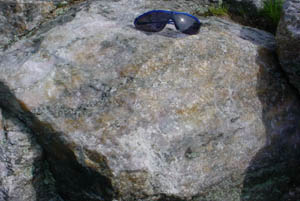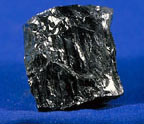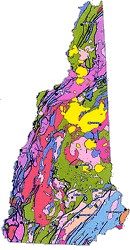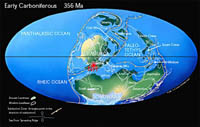Time To Stop And Smell The Rose
Quartz
Just as an awful
lot happened in the Devonian Period in New Hampshire, the reverse is
true of the Mississippian
[miss-iss-SIPP-ee-in] and Pennsylvanian
[pen-sill-VANE-yin] Periods here. Geologically speaking, it's as
if New Hampshire slowed down a little to stop and smell the
roses, or the rose quartz that was just created during the Devonian Period.
(See box at right.) However, this does not mean that
nothing happened to the landscape of New Hampshire at this time - far
from it!
You might notice
that the names of these two periods look like the names of two states.
They are, and there's a good reason for this. All of the
geologic time periods are named for the area on Earth where rocks
of that time period were first identified. You may not have
recognized the other locations because they are named for towns and
regions in European countries.
Two For The Price Of One
The Mississippian
and Pennsylvanian periods are sometimes lumped together as
the Carboniferous Period
[kar-bo-nif-FER-us]. You might notice the word 'carbon' in the
name. That refers to the vast coal deposits found in these two
states. Coal is almost pure carbon. It is the remains not
of any kind of rock, but of plants that lived during this time.
You may have noticed that neither time period in the Carboniferous
Period is the 'New Hampshiran Period'. This is due to two
very good reasons:
Reason
#1
Coal was not discovered here first, in part because
Reason #2
no coal was formed here in New Hampshire.
Welcome To New Hompsha Mon
During the
Carboniferous period, North America was straddling the Equator, with
New Hampshire located just to its south. That means the climate
was tropical - very warm and wet. This played a key role in
fostering the development of the amphibians (the
ancestors of today's frogs, toads and salamanders), some of which were
huge. As a result, another name for this time period is the Age
of Amphibians. They were not the only animal type around, but
they were the dominant one. Towards the end of this age, the
first reptiles showed up. Their 'Age' was still to come and it
will involve the dinosaurs. But that's a story for another time
period.
These conditions
were perfect for huge fern forests (there were no 'trees' like
the ones around today just yet) and vast coal swamps. Coal swamps
are called that today because that is where all the plants grew that
turned into coal later on. They were very lush and green, not
black and dirty, as the name might suggest. These swamps were
turned to coal by being buried under sediments and then squeezed under
intense pressure and heat.
Sediments must flow
downhill from a source that is being weathered and eroded. What
uphill source was there, and where did the pressure and heat come from?
The Press Is On
Remember the Acadian
Orogeny that started back in the Ordovician Period,
more than a hundred million years ago? Well it was still going on
and getting ready for a final big push in our area. The northern
end of the Appalachian Mountains that we know today, were developed to
their fullest extent by the end of this period. They are thought
to have rivalled today's Himalayas (correctly pronounced [him-AHL-yuz],
not [him-uh-LAY-uz]) in height and majesty.
As the mountains
were going up, there was weathering and erosion going on bringing
sediments down the slopes to cover the coal swamps. Over time,
the coal swamps and sediments were caught up in the folding and
buckling of the North American/African plate collision. This
squeeze play supplied the heat and pressure to convert the plants of
the vast swamps into coal.
What Exactly Did Happen In New
Hamphire Then?
Good question.
While no coal was formed here, the Northern Appalachians do run
through our fair state. That means that we have that mountain
building event, in part, to thank for our current mountainous lanscape.
Intruder Alert
Not only that, but during this
period, a blob of magma was rising through the crust, much like a blob
of goo rises in a lava lamp. (Ever wonder why they're called
'lava lamps'?) It intrudes, or enters, already existing rock. In
an intrusion, magma doesn't quite reach the surface. In
most cases, including this one, the intrusion stayed miles underground.
Hundreds of millions of years of weathering and erosion were
needed in order to expose it as today's bedrock. It is a special
form of granite known as two-mica granite. See the map at
right for more details.
|
|
| Rose Quartz |
|

This rose quartz can be found at the top of Pack Monadnock Mountain,
near Peterborough. (The sunglasses are there to give a sense of
scale.) Pack Monadnock is part of the Littleton Formation that
was formed in the Devonian Period.
Quartz is usually made of metamorphosed silicates [SILL-ik-itz],
otherwise known as sand. Different elements mixed with the
silicates give quartz its different colors (smoky, milky, clear and
rose among others).
(Click on the image for a closer look.)|
Image
credit: Daniel E. Reidy
|
| It's Coal - For Peat's Sake |
|
|

Bituminous Coal
|

Anthracite Coal
|
Coal is nothing more than
fossilized peat moss that formed in vast swamps during the Carboniferous
Period. This peat moss was covered over by eons of
sedimentation and then subjected to great heat and pressure. The
end result being bituminous coal (with petroleum (oil) as a by product
given certain temperatures and pressure) or anthracite coal (created
under even greater temperature and pressure and creating natural gas as
a byproduct).
(Click on the image for a closer look.)|
Image
credit: U.S. Congress
|
| Where To
Find Two Mica Granite |
|

Granite usually
contains only one kind of mica. (See the"Granite Recipe" box on
the Devonian Period page.) The granite that
formed during the Carboniferous period contains two kinds of mica,
making it quite unique. The two-mica granite can be seen on the map
below as a dark pink shade with the city of Conway sitting in one
splotch of it about halfway up the state on the Maine border side and
in the Ossipee area a little south of Conway. It can also be
found on the Mid-Massachusetts border.
(Click on the image for a closer look.)|
Image
credit:New Hampshire Geological Survey
|
| Tropical
New Hampshire |
|

(Click on the image for a closer look.)|
Image
credit: Christopher Scotese www.scotese.com
|
|